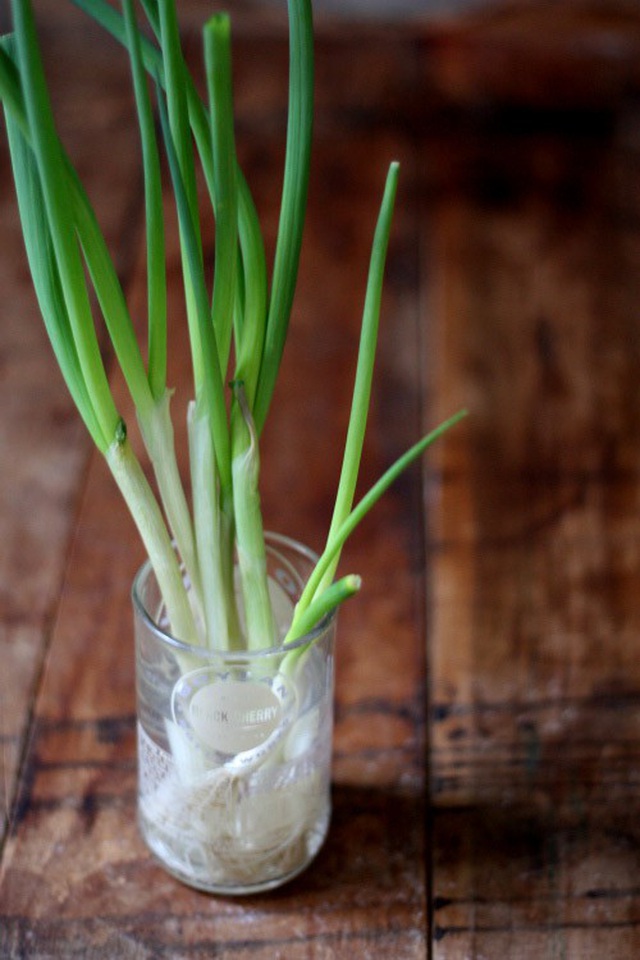To grow water spinach, also known as morning glory, you can use a simple and quick method of stem cutting. After removing all the leaves to aid the process of root and new leaf growth, bury the stems about 5cm deep in soil, leaving 10-20cm of the stem above the ground.
Keep the pot in a cool place and water regularly to maintain moisture. With this care, water spinach will thrive and be ready for harvest in a few days, providing delicious meals soon after.

Grow water spinach through stem cutting.
Amaranth:
Amaranth is an easy-to-grow and low-maintenance vegetable. You can easily propagate amaranth by plucking the leaves for cooking while retaining the remaining stem. First, select sturdy and healthy amaranth stems and remove all large leaves. Then, place them in a cup with water reaching 2-3cm from the base. In about 10 days, the roots will start to grow.
Alternatively, you can plant the stems directly into loose and airy pots and water them daily. With this method, you’ll be able to enjoy freshly grown amaranth in your meals in as little as 20 days.
Chinese Chives:
Chinese chives are a common herb in the kitchen, and you can easily regrow them from their roots. Cut a 5cm long section of the root and plant it in the soil, watering it regularly.
You can also grow Chinese chives directly in small cups of water. Place the cups in a well-lit area, avoiding direct sunlight, and change the water about three times a week. In just one week, the roots will stabilize and begin to sprout new growth.

Chinese chives are a common herb in the kitchen.
Lablab Bean:
When propagating lablab beans, choose healthy stems and plant them at a 45-degree angle, burying them firmly in the soil. Leave 2-3 nodes and a few top leaves to encourage branching.
If you’re growing lablab beans for their shoots, leaves, and stems, space them about 10-15cm apart. However, if you’re growing them for their roots, increase the spacing to 20-30cm. Water regularly, and add straw and organic fertilizer between the rows to maintain moisture and provide shade.
Malabar Spinach:
Malabar spinach is easy to grow from seeds or stem cuttings. Choose healthy, slightly older stems with young leaves and buds.
Plant the cuttings about 10cm apart and water regularly. Keep the pot in a well-ventilated, cool place. Within a month, you’ll be able to harvest the Malabar spinach and use it in various delicious dishes.

Grow Malabar spinach from seeds or stem cuttings.
Celery:
While many people believe that celery can only be grown from seeds, it’s actually quite easy to regrow new plants from the roots of store-bought celery. Cut a 5cm long section from the base of the celery and place it in a cup of water for about a week. When you see the roots starting to sprout, transfer it to a pot or small container and continue watering regularly. In about a month, you’ll be able to harvest fresh, tasty celery.
The Amazing Health Benefits of Kiệu: 6 Reasons to Include This Vegetable in Your Diet. How to Distinguish Kiệu from Onion.
Pickled scallions are a staple of the Lunar New Year celebrations in Vietnam. But did you know about the health benefits of these tangy treats? Scallions, or ‘cu kieu’ as they are known in Vietnamese, have long been prized for their medicinal properties. In this article, we will explore the benefits of cu kieu and how to distinguish it from its close relative, the onion. Stay tuned as we uncover the secrets of this humble yet powerful vegetable!
Is Eating Water Spinach After Surgery Advisable? Can Water Spinach Cause Keloids?
Is water spinach the cause of those unsightly keloid scars? Absolutely not! Read on to discover the truth and learn why this common misconception is simply not true.





































